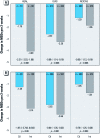Implementation of evidence-based asthma interventions in post-Katrina New Orleans: the Head-off Environmental Asthma in Louisiana (HEAL) study
- PMID: 22894795
- PMCID: PMC3556603
- DOI: 10.1289/ehp.1104242
Implementation of evidence-based asthma interventions in post-Katrina New Orleans: the Head-off Environmental Asthma in Louisiana (HEAL) study
Abstract
Background: Childhood asthma morbidity and mortality in New Orleans, Louisiana, is among the highest in the nation. In August 2005, Hurricane Katrina created an environmental disaster that led to high levels of mold and other allergens and disrupted health care for children with asthma.
Objectives: We implemented a unique hybrid asthma counselor and environmental intervention based on successful National Institutes of Health asthma interventions from the National Cooperative Inner City Asthma (NCICAS) and Inner-City Asthma (ICAS) Studies with the goal of reducing asthma symptoms in New Orleans children after Hurricane Katrina.
Methods: Children (4-12 years old) with moderate-to-severe asthma (n = 182) received asthma counseling and environmental intervention for approximately 1 year. HEAL was evaluated employing several analytical approaches including a pre-post evaluation of symptom changes over the entire year, an analysis of symptoms according to the timing of asthma counselor contact, and a comparison to previous evidence-based interventions.
Results: Asthma symptoms during the previous 2 weeks decreased from 6.5 days at enrollment to 3.6 days at the 12-month symptom assessment (a 45% reduction, p < 0.001), consistent with changes observed after NCICAS and ICAS interventions (35% and 62% reductions in symptom days, respectively). Children whose families had contact with a HEAL asthma counselor by 6 months showed a 4.09-day decrease [95% confidence interval (CI): 3.25 to 4.94-day decrease] in symptom days, compared with a 1.79-day decrease (95% CI: 0.90, 2.67) among those who had not yet seen an asthma counselor (p < 0.001).
Conclusions: The novel combination of evidence-based asthma interventions was associated with improved asthma symptoms among children in post-Katrina New Orleans. Post-intervention changes in symptoms were consistent with previous randomized trials of NCICAS and ICAS interventions.
Conflict of interest statement
The authors declare they have no actual or potential competing financial interests.
Figures



References
-
- Akinbami LJ, Moorman JE, Garbe PL, Sondik EJ. Status of childhood asthma in the United States, 1980–2007. Pediatrics. 2009;123(suppl 3):S131–S145. - PubMed
-
- Akinbami LJ, Moorman JE, Liu X. Asthma prevalence, health care use, and mortality: United States, 2005–2009. Natl Health Stat Report. 2011;32:1–14. - PubMed
-
- Crain EF, Kercsmar C, Weiss KB, Mitchell H, Lynn H. Reported difficulties in access to quality care for children with asthma in the inner city. Arch Pediatr Adolesc Med. 1998;152(4):333–339. - PubMed
Publication types
MeSH terms
Substances
Grants and funding
LinkOut - more resources
Full Text Sources
Other Literature Sources
Medical

